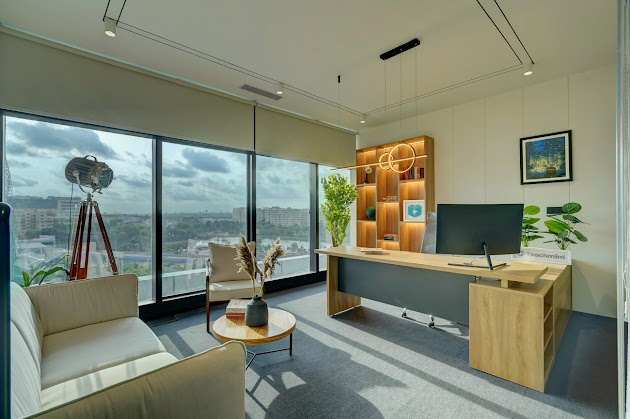The Role of Lighting in Office Interior Design Balancing Natural and Artificial Light
Lighting is an essential but sometimes overlooked part of the ever-changing realm of workplace interior design. It’s not only about illuminating a space—it’s also about fostering the right environment, boosting productivity, and encouraging wellbeing. A monotonous workstation can become an energetic, stimulating space by carefully balancing artificial and natural light.
This post will discuss how the harmony between these two kinds of light may significantly impact the look and feel of your office and the profitability of your company.
Let There Be Light: Why Proper Lighting Is So Important
Before delving into the balance of natural and artificial light, let’s first understand why lighting is crucial in office interior design.
- Productivity Boost: Adequate lighting is a known catalyst for productivity. Lack of focus, exhaustion, and eye strain can result from inadequate lighting. However, well-planned illumination can support workers in being focused and awake in the workplace.
- Mood Enhancement: The proper lighting can influence our mood. Bright, well-distributed light can create a more cheerful and pleasant atmosphere, whereas dim, harsh lighting can lead to irritability and stress.
- Aesthetic Appeal: Lighting is a crucial element of interior design. The type of lighting fixtures, their placement, and the quality of light can significantly affect the aesthetics of your office space, making it more inviting and visually appealing.
The Natural Advantage: Harnessing Sunlight
Natural light is a potent tool in office design. It reduces energy costs and contributes to a more comfortable and vibrant workplace.
- Daylighting: Incorporating large windows and open spaces in your office design allows maximum exposure to natural light. It improves energy efficiency by lowering artificial lighting requirements during the day.
- Health Benefits: There is evidence that being around natural light improves mood, boosts productivity, and lowers stress levels. Moreover, it offers vital vitamin D, which is necessary for good health in general.
- Connection to the Outdoors: A view of the outside world can be refreshing and inspiring. It can help employees stay connected to the changing seasons and the passing of time, making the workspace feel less confining.
- Balance and Control: While natural light is a blessing, it can sometimes be harsh, creating glare and hotspots. It’s essential to have proper window treatments and the ability to control the amount of light coming in. This balance can be achieved through curtains, blinds, or adjustable shading systems.
Artificial Intelligence: The Power of Controlled Light
Artificial lighting is an integral part of office interior design that offers flexibility and control. You can craft the perfect ambiance for your workspace with the right lighting solutions.
- Task Lighting: Task lighting provides focused illumination in work areas, ensuring that employees can precisely perform their tasks. It increases productivity while lowering eye strain.
- Ambient Lighting: Ambient lighting sets the overall mood of the workspace. Depending on your design objectives, it can be adjusted to create a warm, inviting atmosphere or a bright and energetic one.
- Accent Lighting: Accent lighting adds a layer of sophistication to your office design. It highlights artwork, architectural features, and decorative elements, elevating the aesthetics of the space.
- Energy Efficiency: LED lighting systems are energy-efficient and cost-effective. They last longer, reduce maintenance, and allow you to control the illumination level to match your office’s needs.
Striking the Balance
Balancing natural and artificial light is the key to a harmonious office environment. Here’s how to successfully attain this balance:
- Maximise Natural Light: Ensure your office design allows as much natural light as possible. Open floor plans, strategically placed windows, and reflective surfaces can help distribute natural light more evenly.
- Light Control: Implement smart shading systems that automatically adjust based on the time of day and sunlight intensity. It prevents overexposure to sunlight and glare while maximising its benefits.
- Task-Oriented Lighting: Use task lighting to complement natural light. Task lighting fixtures can be adjusted individually, allowing employees to fine-tune their workspace illumination.
- Dimmable Artificial Lighting: Employ dimmable LED lighting systems to match the intensity of artificial light with the time of day. It not only conserves energy but also supports a balanced lighting scheme.
- Integrating Technology: Consider lighting control systems incorporating sensors and timers to adapt to changing conditions. They can help maintain an ideal balance between natural and artificial light throughout the day.
Studio AsA: Crafting the Perfect Office Space
Now that we’ve explored the intricacies of office lighting design, it’s time to introduce Studio AsA. They are a premier interior design firm specialising in commercial spaces, hotels, restaurants, offices, and co-working spaces. Studio AsA understands the importance of lighting in creating inspiring and functional workplaces.
Their expertise allows them to seamlessly blend natural and artificial light to create an office environment that promotes productivity, well-being, and aesthetic appeal. Studio AsA takes a holistic approach, ensuring that your office design optimises using both light sources to enhance the workplace experience. For a workspace to promote health, productivity, and beauty, the proper ratio of natural to artificial light must be achieved. Studio AsA is prepared to turn your workplace into a bright, inviting sanctuary that uplifts your brand and gives your staff a sense of empowerment. Embrace the transformative power of lighting in your office design today.




Comments
Post a Comment